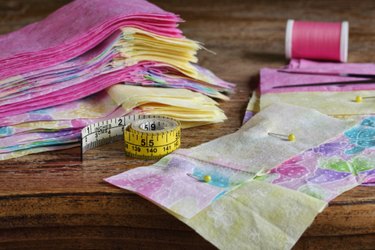Things You'll Need
Original pattern
Tracing paper
No. 2 pencil or softer
Tape (optional)
New work surface (cloth, wood, canvas, etc.)

Whether you sew, carve wood or paint, at some point you will want to transfer an existing design or pattern onto another surface. The surface can be a piece of wood, fabric or canvas. Transfer paper is a convenient way to apply designs or patterns onto a new project. If you don't have transfer paper you can still copy what you need using pencil and tracing paper if needed.
Paper Patterns (such as sewing patterns)
Step 1
Turn your pattern over and trace along the pattern's lines with the pencil. If the paper is too think to see through on your work table, tape the pattern on a window to see through the paper.
Video of the Day
Step 2
Lay the pattern (pencil-marked side down) over your new work surface and draw over the lines. If you are working with a large pattern, tape it to your new work surface to hold it in place. As you draw over the original lines, the pencil marks you made on the other side of the pattern are transferred onto your new work surface.
Step 3
Lift the pattern to check if you missed any areas. Once you have transferred all of the pattern, remove the pattern. If the marks on your new work surface are faint you can go over them again with the pencil.
Patterns From Books, Wood or Other Objects
Step 1
Lay the tracing paper over the design or pattern you want to copy. Trace the design and set aside the original design. Turn the tracing paper over and re-draw the pattern on the back side of the paper (if you don't mind that the pattern is reversed or if it is a symmetrical pattern, you can skip re-drawing the design on the back side).
Step 2
Lay the tracing paper with the back side down (or pencil-marked side if you didn't re-draw on the back) on your new work surface. Draw along the pattern's lines with the pencil. If you are working with a large pattern, tape the tracing paper to your new work surface to hold it in place. As you draw over the original lines, the pencil marks you made on the other side are transferred onto your new work surface.
Step 3
Lift the pattern to see if you missed any areas. Once you have transferred all of the pattern, remove the tracing paper. If the marks on your new work surface are faint you can go over them again with the pencil.
Tip
If you don't want to mark up your original pattern, trace it onto tracing paper first. If your new work surface is dark, use a piece of chalk or a soft white pencil rather than the No. 2 pencil
Video of the Day